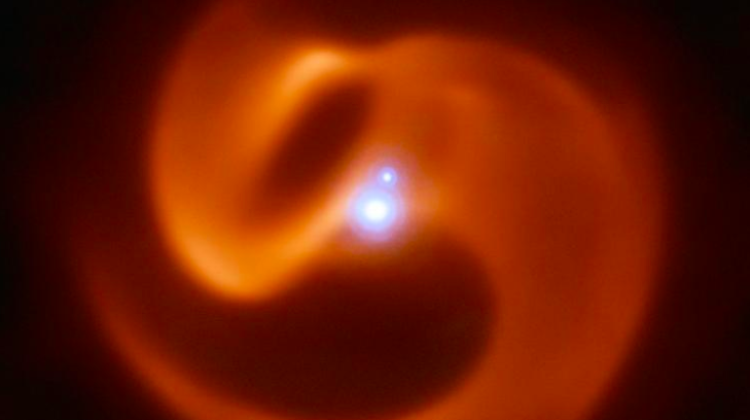Astronomers photographed the effect of colliding stellar winds
 Dust cloud surrounding the triple star system 2XMM J160050.7-514245 (informally called Apep). The pinwheel structure is generated by the collision of stellar winds from two Wolf-Rayet stars. Credit: ESO/Callingham et al.
Dust cloud surrounding the triple star system 2XMM J160050.7-514245 (informally called Apep). The pinwheel structure is generated by the collision of stellar winds from two Wolf-Rayet stars. Credit: ESO/Callingham et al.
A photograph of recently discovered triple star system was presented by the European Southern Observatory (ESO). The structure it shows is an effect of the collision of stellar winds. Polish researcher working in Australia participated in the project.
The photograph shows a triple star system surrounded by dust vortex. The system`s official designation is 2XMM J160050.7-514245, but researchers nicknamed it "Apep", after an ancient Egyptian deity depicted as a giant serpent. In Egyptian mythology, Apep was the serpent (also known as Apophis) that the sun god Ra fought every night. The inspiration is the shape in the picture, resembling a coiled snake.
The photo was taken using the VISIR instrument on ESO’s Very Large Telescope at the Paranal Observatory in Chile. The research team led by Joseph Callingham of the Netherlands Institute for Radio Astronomy (ASTRON) also used the Anglo-Australian Telescope (AAT) at Siding Spring Observatory, Australia.
Among the authors of the publication is a Polish researcher - Dr. Lucyna Kędziora-Chudczer, astronomy graduate at the Jagiellonian University in Kraków, who lives in Australia and works at the University of New South Wales in Sydney. She participated in infrared observations of this object.
"I performed observations (...) with the 3.9-meter Anglo-Australian Telescope. The infrared detector called IRIS2 was used for photography and spectral observation. This telescope is the largest optical telescope in Australia. Thanks to the observations we were able to determine the speed of the stellar wind in this system (its gas component)"- Dr. Kędziora-Chudczer says in an interview with PAP.
The system in question is a triple system consisting of a single star and two Wolf-Rayet stars in a tight orbit around each other. Some of the most massive stars at the end of their lives evolve to become Wolf-Rayet (WR) stars. They remain for only a few hundred thousand years at this phase, which is a short time compared to the age of the stars. During this phase, the star loses enormous amounts of matter in the form of a very strong stellar wind moving at speeds of millions of kilometres per hour - for example the speed of the wind in the Apep system is 12 million km/h (3400 km/s).
Stellar winds are responsible for the structure visible in the photograph - the winds from two Wolf-Rayet stars collide. In addition, the dust moves much slower than the stellar wind (2 million km/h). Scientists suggest that such a big speed difference means that one of the WR stars throws off winds at different speeds in opposite directions.
The observed properties may suggest that the star has a near-critical rotation, meaning that it is rotating so fast it is on the verge of ripping itself apart. Researchers suspect that WR stars with such rapid rotation may generate long-duration gamma ray bursts.
According to the Polish-Australian astronomer, the causes and mechanisms of gamma ray bursts are still being debated. Astrophysicists believe that they are powerful explosions that come from supernovae, kilonovae, but also from rapidly rotating stars in the final stages of evolution. Gamma bursts are distinguished by their duration. In general, there are two groups: short-duration bursts (about a second) and long-duration bursts (about a minute). Short gamma ray bursts are easier to detect because they can release incredible energy in a short time and are visible from long distances.
"In turn, models of long-duration gamma ray bursts suggest that they can come from rapidly rotating stars. During their evolution, stars usually slow down their rotation, so rapidly rotating stars can usually be found in binary systems, where one star expands and loses matter. The second star intercepts this matter and as a result it starts to rotate faster, on the same principle as a skater who speeds up rotation during the pirouette, when pushing the arms closer to the body" - explains Dr. Kędziora-Chudczer.
This is why the Apep system is very interesting for astronomers: as an example of a precursor (progenitor) of gamma ray bursts.
"This is the first such system to be discovered in our own Milky Way Galaxy. We never expected to find such a system in our own backyard" - comments Joseph Callingham from the Netherlands Institute for Radio Astronomy (ASTRON).
The research has been published in the journal Nature Astronomy.
PAP - Science in Poland
cza/ ekr/ kap/
tr. RL
Przed dodaniem komentarza prosimy o zapoznanie z Regulaminem forum serwisu Nauka w Polsce.















